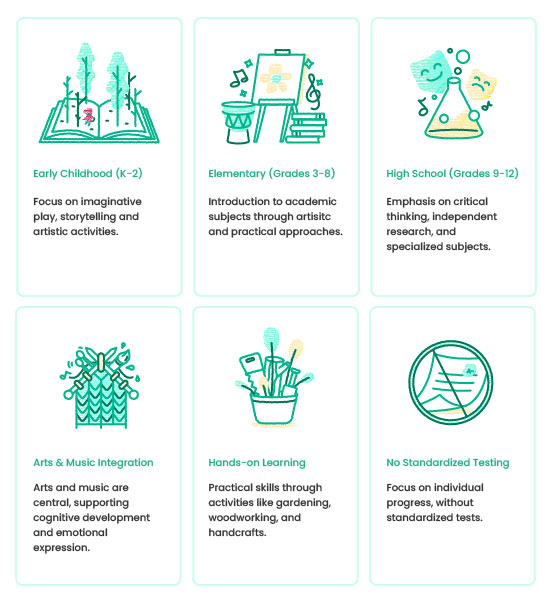What is a Waldorf School?
Waldorf schools offer a unique approach to education that emphasizes holistic development and creativity. Founded by Rudolf Steiner in the early 20th century, Waldorf education has grown in popularity worldwide due to its distinctive Waldorf school philosophy and educational methods. This article will explore the philosophy behind Waldorf education, its curriculum, school locations, and the differences between Waldorf high school and middle school.
The Philosophy Behind Waldorf Education

The core principles of Waldorf education are rooted in the teachings of Rudolf Steiner, an Austrian philosopher and educator. Steiner’s vision was to create an educational system that nurtures the intellectual, artistic, and practical skills of students in an integrated and holistic manner.
- Holistic Development: Waldorf education focuses on the overall development of the child, including physical, emotional, intellectual, and spiritual growth.
- Creativity and Imagination: Emphasis is placed on fostering creativity through arts, music, and hands-on activities.
- Developmental Approach: The Waldorf education curriculum is designed to align with the developmental stages of children, making learning engaging and age-appropriate.
The Waldorf School Curriculum
The Waldorf education curriculum is distinctive, diverse, and integrates arts into all aspects of learning. This holistic approach nurtures intellectual, emotional, and physical development.
Arts and Music
Arts and Music: Arts and music are central to the Waldorf curriculum. Students engage in activities like painting, drawing, singing, and playing musical instruments. These activities are not only creative but also support cognitive development and emotional expression. Research has shown that engaging in arts education can improve memory, enhance social skills, and boost overall academic performance. The integration of arts into daily learning helps students to:
- Enhance Creativity: Encouraging creative expression through various artistic mediums.
- Develop Emotional Intelligence: Using music and art to explore and express emotions.
- Improve Cognitive Skills: Linking artistic activities with improved memory, attention, and problem-solving skills.
For more on the benefits of integrating arts into education, check out our TUIO Blog on creative learning techniques.
Why It’s Beneficial:
- Arts and music foster an appreciation for beauty and culture, enhancing students’ ability to perceive and create.
- Regular engagement in artistic activities can improve students’ focus, reduce stress, and boost their overall well-being.
- These activities encourage self-expression and creativity, which are crucial for personal development and academic success.
Hands-on Learning
Hands-on Learning: Hands-on learning is a key part of the Waldorf school philosophy. Practical skills are emphasized through activities such as gardening, woodworking, and handcrafts. These experiences help students connect with their environment and develop fine motor skills. The hands-on approach benefits students by:
- Promoting Practical Skills: Teaching valuable life skills that can be applied outside the classroom.
- Enhancing Understanding: Providing concrete experiences that help students grasp abstract concepts.
- Encouraging Environmental Awareness: Fostering a connection with nature and an understanding of ecological principles.
Explore how hands-on learning can transform education in our TUIO Blog about practical skills in modern education.
Why It’s Unique:
- Hands-on learning experiences are integrated into daily lessons, making learning more engaging and relevant.
- This approach encourages students to become active participants in their education, fostering a love for learning.
Developmental Stages

Developmental Stages: The curriculum is divided into three main stages, each tailored to the developmental needs of children at different ages:
- Early Childhood (Kindergarten to Grade 2): Focus on imaginative play, storytelling, and artistic activities. This stage emphasizes the importance of play in learning, which helps children develop social skills, creativity, and early literacy skills.
Benefit: These activities support emotional and social development while laying the foundation for academic learning. - Elementary Education (Grades 3 to 8): Introduction to academic subjects through artistic and practical approaches. Subjects like mathematics, science, and history are taught using stories, visual arts, and physical activities, making learning engaging and memorable. This method helps in retaining information better and understanding complex concepts through relatable contexts.
Benefit: This stage balances intellectual growth with emotional and physical development, promoting well-rounded learners. - High School (Grades 9 to 12): Emphasis on critical thinking, independent research, and specialized subjects. Students engage in projects, presentations, and research, fostering independence and a deeper understanding of their subjects. This stage prepares students for higher education and life beyond school, equipping them with essential life skills such as critical thinking and time management.
Benefit: Prepares students for higher education, careers, and adult life, encouraging intellectual independence and responsibility.
Why It’s Beneficial:
- The developmental approach ensures that the educational content is age-appropriate, meeting students where they are in their growth.
- This method respects the natural progression of child development, reducing stress and promoting a healthy learning environment.
Absence of Standardized Testing
Absence of Standardized Testing: Waldorf schools do not use standardized tests. Instead, assessment is based on teacher observations, student work, and individual progress. This approach benefits students by:
- Fostering Individual Growth: Allowing teachers to focus on each child’s unique strengths and areas for improvement.
- Reducing Stress: Eliminating the pressure and anxiety associated with high-stakes testing.
- Encouraging Holistic Evaluation: Providing a more comprehensive view of a student’s abilities and development.
Why It’s Unique:
- Assessments are personalized and qualitative, offering deeper insights into a student’s progress than quantitative scores.
- This approach promotes a growth mindset, encouraging students to see learning as a continuous and personal journey.
Learn more about alternative assessment methods in our TUIO Blog on personalized learning evaluations.
Other Unique Aspects and Benefits:
- Integration of Arts into Core Subjects: Unlike traditional schools where arts are often seen as separate from core subjects, Waldorf education integrates arts into all aspects of learning. For example, math lessons might include geometric drawing, and history lessons might involve dramatizations. This integration helps students understand and retain complex information by engaging multiple senses and learning styles.
- Eurythmy: A unique aspect of the Waldorf curriculum is Eurythmy, an expressive movement art designed to integrate physical movement with learning. Eurythmy helps improve coordination, concentration, and rhythmic skills, contributing to the holistic development of the child.
- Seasonal Festivals: Waldorf schools often celebrate seasonal festivals that reflect the cycles of nature and the rhythms of the year. These festivals build a sense of community and connection to the natural world.
Waldorf School Locations and Options

Waldorf schools are present in many countries worldwide, reflecting a diverse and growing community.
Global Presence: There are over 1,000 Waldorf schools in more than 60 countries. This global presence highlights the universal appeal of Waldorf education.
Finding Waldorf Schools: To find a Waldorf school near you, visit directories such as the Association of Waldorf Schools of North America (AWSNA) or the International Association for Steiner/Waldorf Early Childhood Education (IASWECE).
Notable Waldorf Schools and Alumni:
- High Mowing School in New Hampshire, USA, offers a comprehensive Waldorf high school education.
- Michael Hall School in the UK is known for its vibrant community and extensive arts programs.
- Notable alumni include actress Jennifer Aniston and filmmaker Kenneth Branagh, both of whom have credited their Waldorf education with fostering their creativity and critical thinking skills.
Typical Waldorf School Tuition Amounts
The cost of attending a Waldorf school can range from $7,000 to $20,000 annually, with some schools in metropolitan areas charging upwards of $25,000. Understanding these tuition ranges is crucial for setting competitive and sustainable tuition rates for those interested in opening Waldorf school locations.
To streamline tuition management and billing processes, consider using TUIO’s Tuition Management System. TUIO can help save time and enhance your school’s financial health by automating these tasks.
Why This Matters for Prospective Waldorf School Owners
Understanding the typical tuition range is crucial for setting competitive and sustainable tuition rates at your own Waldorf school. It’s essential to balance affordability for families with the financial needs of running a high-quality educational program.
To manage your school’s tuition effectively and streamline the billing process, consider using TUIO’s Tuition Management System. Learn more about how TUIO can help you simplify tuition management, save over 40 hours per month, and enhance your school’s financial health.
Differences Between Waldorf High School and Middle School
While Waldorf high school and middle school programs follow the same educational philosophy, each level has unique focuses:
Middle School (Grades 6 to 8):
- Focus on building foundational knowledge in subjects like math, science, history, and literature.
- Continued emphasis on arts, music, and practical skills.
- Development of social skills and collaborative projects.
High School (Grades 9 to 12):
- Emphasis on specialized subjects and in-depth study.
- Encouragement of independent research and critical thinking.
- Preparation for higher education and vocational pathways.
The curriculum for high school students is designed to challenge them intellectually while supporting their emotional and social development. Teachers aim to cultivate a sense of responsibility, independence, and a lifelong love of learning.
Conclusion
Waldorf education offers a holistic and creative approach to learning, designed to nurture the whole child. By understanding the Waldorf school philosophy, curriculum, and Waldorf school locations, parents and educators can appreciate the unique benefits of this educational model. To explore Waldorf education further or find a Waldorf school near you, visit the provided links and consider scheduling a visit.


